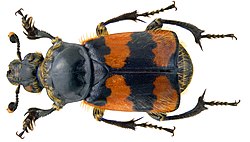| Nicrophorus vespillo | |
|---|---|
 | |
| Scientific classification | |
| Kingdom: | Animalia |
| Phylum: | Arthropoda |
| Class: | Insecta |
| Order: | Coleoptera |
| Suborder: | Polyphaga |
| Infraorder: | Staphyliniformia |
| Family: | Silphidae |
| Genus: | Nicrophorus |
| Species: | N. vespillo |
| Binomial name | |
| Nicrophorus vespillo | |
| Synonyms | |
List
| |
Nicrophorus vespillo is a burying beetle described by Carl Linnaeus in his landmark 1758 10th edition of Systema Naturae. It has a paleartic distribution and is commonly found across Europe and Asia, extending from Western Europe to Mongolia. [1]

